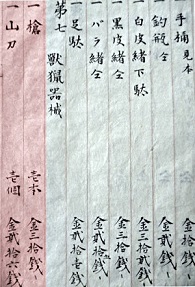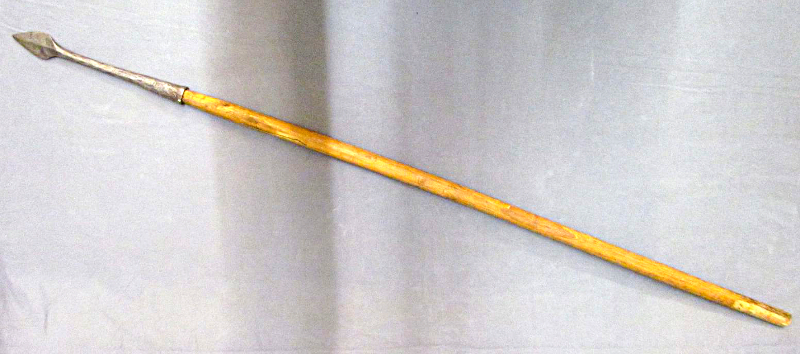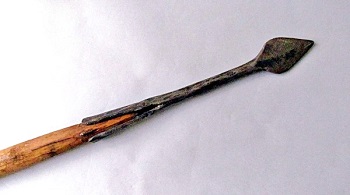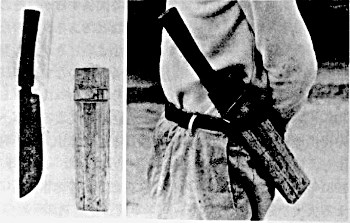
mong the everyday commodities of Okinawa are a number of tools which can be used in the martial arts. For example, equipment used in the mountains (hatchet, etc.), by fishermen (harpoon, etc.), in agriculture (hoe, etc.), or by craftsmen (plane, etc.). Of course, this also includes hunting equipment.
As had been noted recently by the Motobu-ryu facebook page, in 1884, the German government purchased 543 objects from Okinawa, with the Japanese government acting as an interim.

Acquisition List 1884. Photo credit: Dr. Siegmar Nahser, Staatliche Museen zu Berlin-PK, Ethnologisches Museum.
From among this important acquisition, all fabrics have been described and recorded in pictures. Over the years they have been put in display a few times, including on Okinawa. They were finally published in an excellent work by Mrs. Shukumine, Naha.
However – and as also having been pointed out by the Motobu-ryu -, both in the German as well as in the Japanese acquisition list of 1884 were also found a yari 槍 (spear) and yamanaji 山鉈 (hatchet), described as “hunting tools” (Jagdgeräthe) – and these were the only two objects from this category. But both these objects were not included in the above mentioned works and exhibitions. No image data or details about these two hunting tools had been published so far.
In addition, both yari and yamanaji were hitherto not included in the internal database of the Ethnologisches Museum Berlin. In other words: The whereabouts of these two objects were unknown so far.
However, after sending a research request, Dr. Nahser from the Ethnologisches Museum Berlin went to check the actual physical collection.
Unfortunately, the yamanaji turned out to be a loss of war taken to an unknown location.
But the yari is still present and has only been rediscovered by this research request. The yari, which had been bought for the price of 30 sen back in the days, consists of a wooden shaft and an iron spearhead. It is connected without the use of nails, rivets or other fasteners. In order to join together the shaft and spear head, a conical connection is used. Here we see a reasonable explanation for the origin of the conical tapering of the Okinawan bō or fencing cudgel.

Yari manufactured around the end of the Ryūkyū kingdom era. Photo credit: Dr. Siegmar Nahser, Staatliche Museen zu Berlin-PK, Ethnologisches Museum. (SMB-PK Inventary number I D 6968).
According to Motobu Naoki Shihan of Motobu-ryū and Motobu Udundī, this connection is called fukuro-yari, or socket type spearhead. In his evaluation of the rediscovered spear, Motobu Shihan noted “It was the first time I saw such a type of Okinawan spear. Spears from the time prior to WWII hardly survived in Okinawa. Therefore, this is an epoch-making discovery.“

Fukuro-yari connection, or socket type spearhead. Photo credit: Dr. Siegmar Nahser, Staatliche Museen zu Berlin-PK, Ethnologisches Museum. (SMB-PK Inventary number I D 6968).
Where does this hunting spear come from? Maybe from Motobu or Yanbaru. The northern part of Okinawa main island as well as the Yaeyama Islands of Ishigaki and Iriomote are inhabited by wild boar. There an ancient subspecies of wild boar exists still today, called the Ryūkyū Inoshishi (Sus scrofa riukiuanus). Although their length and weight differs in each island, they are all fairly small, with a body length of 90-110cm and a body weight of about 20-70kg. Nowadays wire traps are laid out, but in olden times they were hunted using spears, and there were many cases of hunting with dogs, which was called inuhiki. The dogs cornered the boar so that it could be thrusted with the spear. In the local dialect of Kunigami this spear was referred to as yamashishi-yai, while in Yaeyama it was called puku (jp. hoko). It means a spear for hunting wild boar (inoshishi yari).
Next, let us explore the Okinawa Prefectural Museum. There was exhibited such a yamashishi-yai (wild boar spear) or puku, respectively. It is described a spear for hunting wild boars. However, this spear is probably from after WWII. But it appears to be of the same type as the rediscovered spear from 1884.

Spearhead of yamashishi-yai (wild boar spear) or puku. Photo by A. Quast: Okinawa Prefectural Museum, May 2009.
How about the hunting spear in traditional culture?

The Kumi-odori called “Motobu Ufunushi”: Ganachiku and his eibō, pointing downwards.
As can be seen in the Kumi-odori called “Motobu Ufunushi” AKA “The Vengeance of Hokuzan”, the boar-spear is a historic hunting tool. Therein appears the character of Ōgimi Ganachiku, a man who goes hunting with his dog. He carries a spear referred to as eibō (spear-cudgel). It seems that eibō was a name for such a hunting spear in northern Okinawa in olden times. As can be seen in the Kumi-odori, the spearhead was always held pointing downwards when walking in the mountains. In this way the hunter was always able to thrust right away if danger occurred, like an attacking boar, a snake, or other animals.
Such eibō (spear-cudgel) were excavated at the Yaeyama Gantō ruins as well as in the old Tombs of Naha Nakandakari-yama. They are considered spears from the early modern Ryūkyū kingdom era.

Sagiyai (hanging spear used for hunting wild boar). Photo by A. Quast: Okinawa Prefectural Museum, May 2009.
According to the above, the rediscovered 1884 spear was used for hunting small Ryūkyū wild boar. And it was known under various names.
In addition, in the Kunigami district there is the so-called sagiyai (hanging spear used for hunting wild boar) which usually has three spearheads fixed to a rootstock. It was hung up on a tree with the wooden shaft on top, and food placed underneath it to entice the boar. When they came for the food, the spear was dropped.
Let’s return to the yamanaji. The yamanaji is a sort of woodman’s hatchet or slasher used in the mountains. Its shape is similar to the blade of a naginata or even a kitchen knife. It is found distributed from the Tokara Islands up to Yaeyama. On Tokara it is called yamaki, in Yaeyama it is called yangarashi. It is the original woodman’s hatchet of Japan and widely used in the whole Ryūkyū area for logging small trees and the like. According to Motobu Naoki Shihan of Motobu-ryū and Motobu Udundī, the martial art of yamanaji-jutsu had been handed down in the Motobu Udundī. There is a difference between the yamanaji and the short-sword-like yamagatana of mainland Japan. That’s why it is important to call it the Ryūkyū yamanaji.

Ryūkyū yamanaji. From: Okinawa Daihyakka Jiten, Vol. III, 1983.
© 2015, Andreas Quast. All rights reserved.
